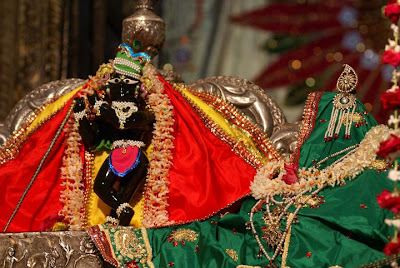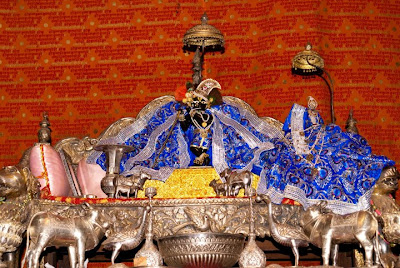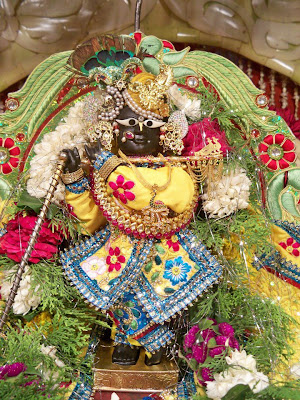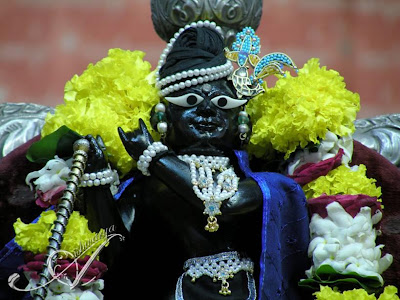Sri Radharaman Temple was established by Gopal Bhatta Goswami.
This is Ramanji in His Aulai outfit. The Aulai darshan is for sandhya aarti in the early evening. Aulai means "I'm bringing (dinner)" as Krishna is all cleaned up from cow-hearding, and is impatient to eat as He's hungry, and so Yashoda, says "Aulai, Aulai" to pacify Him that she's bringing Him His food...
The Deity of Sri Radharaman was manifested from one of Gopal Bhatta Goswami's salagram-silas on the full moon day of Vaisakha (April/May) in 1542.
This event is celebrated every year (May) by bathing the Deity with 100 liters of milk and other auspicious items. Gopal Bhatta Goswami's other salagram-silas are also worshiped on the altar. There is no Deity of Radharani with Radharaman, but gomati-cakra is worshipped on the altar to His left. According to an injunction of Sri Hari-bhakti-vilas, a gomati-cakra is to be worshipped along with a salagram-sila.
Radharaman is one of the few original Deities of the Goswamis still in Vrindavan. Other Deities went to Jaipur, but Radharaman never left Vrindavan. The fires for cooking in the temple kitchen have been burning continuously for over 435 years, since the Deity was installed. This is so no foreign elements, such as matches, are used for ignition purposes.
The Temple is located at the end of the road coming from the walled Nidhuvan gardens.
One rich businessman made an offering of clothes crowns, and jewllery to Srila Gopal Bhatta Goswami, who lamented that, as he was worshipping Sri Shaligram which was round just like a stone he could not dress, or put crowns and jewellery like the other Goswamis were doing with their Deities. Lamenting in this way, the Goswami took rest. Early the next morning when he came to offer the seva arpanam puja for the Shaligrams he discovered that one of the Silas (Damodar) had transformed into the most beautiful three fold bending Deity of Krishna, Who had manifested Himself out of love, just to receive loving worship from Gopal Bhatta Goswami. The name Radha Raman means "one who gives pleasure to Srimati Radharani". This is one of the numerous names of Lord Sri Krishna. There is no external manifestation or Deity of Srimati Radharani in the temple but there is a crown next to Ramanji that represents Her presence.
This is the entrance to the Radha Raman Gosai compound
Just as a word of caution, these days there are many micheivious monkey who lurk around the walls and roof tops of this compound waiting for unsuspecting pilgrims who they then pounce upon and steal your glasses, bead bags or any food that you may be carrying to bring as an offering to the Deity. Be careful and remove any such items and keep all items in your bag and out of their sharp eye's reach.
....if you look carefully you will notice one monkey sitting waiting on the balcony for his moment.......and a few over to the left.
There's a safe place to keep shoes just around to the right, and for a very small donation someone will guard your shoes from the monkeys.
DO NOT leave shoes outside the temple door as these people have, and PLEASE DO NOT take them inside the door.
Timings:
Summer - Mangala Arati 4:00am
Darshan - 08:00am thru' 12:30pm
(look out for the green light when you first enter the Gosai compound, up on the left)
(If it is red then darshan is over)
Evening Darshan: - 6pm - 8pm (18:00 - 20:00 hrs)
Winter - Mangala Arati 05:30am
Darshan - 08:00am - 12:30pm
Evening - 6pm - 8pm (18:00 - 20:00 hrs)
Zoomed in for close-up darshan
The standard of worship at samadhi and temple is exemplary and Srila Prabhupada wanted his disciples to learn Deity worship from local pujaris.
Radharaman Riding Silver Elephant
http://www.dandavats.com/?p=1635
October 2nd 2006 was the Rama Vijayotsava, also known as Dasshera, the day that Lord Ramacandra conquered over Ravana. On this day every year, Sri Sri Radharamanaji performs a victory ride on a huge 4? silver elephant. This year Sri Padmalocan Goswami was the pujari for this event. We waited anxiously till almost quarter to seven to relish this incredible darshan.
After aratika, Padmalocana Goswami surprised us all by taking the Salagram Silas in an ornate silver cart on a Rathayatra circumambulating Sri Radharamanji. Unfortunately, he was moving too fast for us to get a good photo of the Rathayatra. The photos presented here were taken by a Swedish disciple of Devamrita Swami named Karunapurna Devi Dasi, who is on her first visit to the Holy Dhama, Sri Vrindavan.
Sri Sri Radharamana lala ki jaya!
In service of Srimati Vrinda Devi,
Deena Bandhu das
Following are a couple of pictures of His undergoing an Abhishek bathing ceremony,
where He is bathed in pleasing items such as milk, yogurt, ghee, sugar water and honey.
Being bathed in cow's milk
Half covered still in yogurt, the ghee is poured over His Divine form
After all the auspicious items are offered to Him He is bathed again using waters from the Sahasra-dhara sieve
This black and white shot shows RadhaRaman's real natural beauty and fine detail. Skeptics have speculated that His fine features were carved but devotional scientists from Indian universities have concluded that there are no marks on His body to suggest that He was in any way carved or otherwise manipulated by man. His form as you see it here is cent per cent swayam vyakta - self manifesting. Sri Sri Radha Raman ki jaya
Radha Raman dressed in Sandalwood pulp for Chandan yatra
Sri Caitanya Mahaprabhu's kaupina (cloth) and asana (seat), which Gopal Bhatta Goswami brought from Jagannath Puri, are also in this temple. They are brought out to be seen by the public three or four times a year. The asana is black wood and is about 30 cm (12") by 25 cm (10").
Before large temples were built, the Goswamis worshiped their Deities simply, keeping them in a tree under which they slept......Radha-raman Deity was adored in a tree for centuries. In the area of the present Radha-raman temple, there used to be a large lake, connected to the Yamuna river......For a couple of hundred years they worshiped Radha-raman in a tree, and at night put him in a boat anchored in the middle of a lake......They stood guard with bows and arrows, if anyone came to hassle the Deity. Even today, they have the bows and arrows in the temple.
Besides daily puja there are other festivals held at the samadhis. Upon taking initiation into Gaudiya-vaisnava Sampradaya, a new disciple may sponsor a special uttsava (festival) consisting of hari-nama sankirtana (chanting of the name of the Lord), bhagavatha-katha (discourses about the Lord) and offer an opulent feast of prasadam to present Vaisnavas and Braja-vasis (residents of Vrindavan).
The Radharaman Temple was not attacked by Aurangzeb's soldiers because they mistakenly thought it to be just residential quarter. Because of this Radha Raman ji never left Vrindavan like so many of the other Goswami's Deities.
Gopal Bhatta Goswami's samadhi is to the left after you enter the first gate from the street into the temple compound. Gopal Bhatta Goswami was the son of Vyenkatta Bhatta, a brahmana priest of Srirangam Temple in Tamil Nadu. His uncle Prabhodananda Sarasvati also became his spiritual master. In 1511 Sri Chaitanya Mahaprabhu visited Srirangam a danced in ecstasy before Lord Ranganath...
...Vyenkata Bhatta invited Lord Chaitanya to stay at his house during Chaturmasya in Sri Rangam. Gopal Bhatta was at that time small boy and got the chance to serve the Lord and hear directly from Him. After some time Lord Chaitanya left on his tour to South India and told Gopal Bhatta to go in the future to Vrindavan...
...Gopal Bhatta became learned in Sanskrit, poetry, rhetoric and all aspects of devotional service. After passing of his parents, he left home and proceeded towards Vrindavan where he joined Rupa and Sanatan...
...After some time studying in Vrindavan Gopal Bhatta made a trip to Nepal. One day when he was taking bath in Kali-Gandakini river, he dipped his kamandalu into the water and 12 silas mysteriously entered his water pot...
...He put them back into the water and dipped the kamandalu again in the water of the holy river, but the silas again entered his water pot...
...When it happened for the third time, Gopal Bhatta realized, that those are not ordinary stones, but they must be some very special ones and there must be some divine arrangement behind it. He kept them in a cloth bag hung around his neck and from that time on he started to worship them and then returned to Vrindavan...
...As previously mentioned, once he intensely desired to decorate his salagram as the other Goswamis could decorated their Deities, then seat Him on a swing and serve Him as other devotees can. "If only He had arms and legs like a Deity," he thought...
...Lord Krisna, being very kind to His devotees, that very night transformed Himself from one of small salagram-sila into threefold form of Radharaman. If one has darsan of Radharaman's back, one will see that it resemble salagram-sila. Although the Deity is quite small many devotees find Him to be extremely attractive.
The appearance place of the Sri Radharaman Deity is next to the temple besides Gopal Bhatta's samadhi.
Gopal Bhatta was actually originating the Sat-Sandarbhas, later elaborately developed by Jiva Goswami, he also edited Hari-bhakti-vilas which Sanatan Goswami edited to call Dik Darshini Tika. His most prominent disciple was Srinivas Acharya.
Gopal Bhatta Goswami was no other than Ananga Manjari, one of the eight intimate maidservants of Srimati Radharani.
You can read more about Srila Gopal Bhattar Goswami HERE
Yours
Dinesh
Blog:http://dinesh-krsna.blogspot.com












































